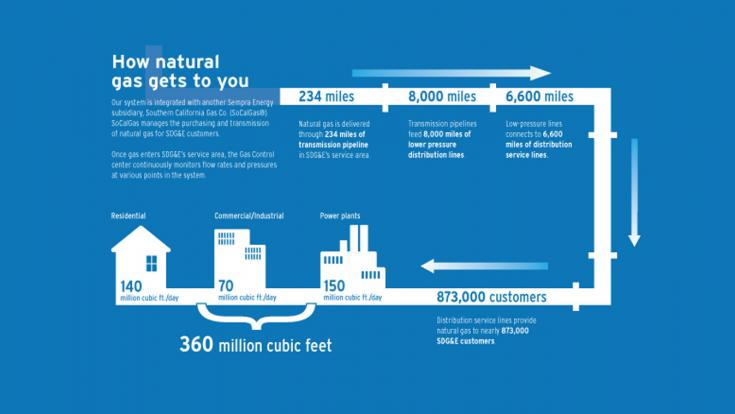The pipes that deliver natural gas to most of our homes and businesses are underground, so we don’t always think twice when we’re cooking a meal or warming our home how the natural gas system works. But, just like most of the electric system we see above ground, the below-ground infrastructure of the natural gas system is equally important.
SDG&E and Southern California Gas Company (SoCalGas) work together to operate the integrated natural gas system that encompasses most of Southern California. SDG&E’s service area encompasses all of San Diego County, consists of more than 230 miles of large high-pressure transmission pipeline which make up the “backbone” of the natural gas system and nearly 15,000 miles of lower pressure distribution and individual service lines that bring the natural gas to our homes and businesses.'
Safely delivered to your home
On an average day, San Diego residents and businesses use more than 360 million cubic feet of natural gas to fuel area restaurants, hotels, schools, manufacturing facilities and the military. Natural gas also fuels most of the regions power plants that generate electricity. At SDG&E, we believe that safety is of utmost priority, which is why we have skilled crews who are focused day after day on ensuring the safety of the natural gas system.
These crews perform leak and corrosion surveys, meter installations or replacements, valve maintenance and any maintenance and construction related to repairs or pipeline projects to ensure the system is operating safely, reliably and efficiently.
Crews also perform inspections on other equipment like pressure regulator and compressor stations. Large high pressure pipelines – transmission lines – running underground are also inspected internally. This is achieved by using highly sensitive tools that are sent into a pipeline to check for any dents or corrosion or any other irregularities.
How you can help
One of the most common causes of pipeline leaks is from damage caused by third-party contractors or residents who don’t call for markup of lines before they dig. If you or your contractor is digging to plant a tree or start a landscape renovation, call 8-1-1 at least two days prior to digging to makes sure there isn’t a utility line below, including a natural gas line.
In addition to monitoring and maintaining the system 24/7, SDG&E works with SoCalGas to ensure there’s enough gas to meet our customers’ needs each and every day, so that there are no issues when it comes to turning on that gas range or oven or turning on the faucet for hot water.


